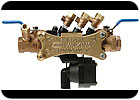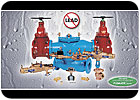
With less than one percent of the world’s water supply available for consumption, keeping the public water supply safe is a main concern, especially for backflow preventer manufacturers. This segment of the industry has been finding ways to keep costs down while complying with extensive testing requirements, laws and regulations.
Manufacturers and distributors agree that smaller, more compact designs are the driving force behind the latest trend in backflow prevention. According to Danfoss Flomatic Corp. Vice President Sales and Marketing Nick Farrara, “Backflow preventers are becoming smaller, lighter and more compact in general.” Kris Munson, national marketing manager for Watts Water Technologies, agrees, explaining, “We are seeing lighter weight units and shorter overall lay length. As mechanical rooms tend to get smaller every year, having a backflow preventer that is lightweight and has a short overall lay length is important to designers and installers since space is at a premium. Having a device that is easy to service is an added benefit.”
However, some feel this compact trend is a drawback when it comes to servicing these valves. The challenge some installers are finding is that the smaller these devices get, the harder they are to repair in the field. “One of the driving forces in making a smaller, more compact design is cost savings,” says Brad Noll, director of engineering at Wilkins, a Zurn company. “The smaller the valve, the smaller the access cover, and the more difficult it is to reach in the valve and get in there. The concern is that these devices are made so small that you end up damaging the device in an attempt to repair it. So, in many cases we’re seeing a trend toward simply removing and replacing these devices, instead of repairing them.”
Noll believes that wholesalers need to be promoting the repairability, not the replacement of the products. “The end-user is really the one who’s going to pay - it’s much more expensive - because they’re the ones actually having a new device installed. It’s kind of a disservice to the customer, the way we see this trend moving,” he adds.
Distributors like BAVCO (Long Beach, CA) have found pricing to be an issue within this segment of the industry. According to BAVCO President Jim Purzycki, “In the old days, manufacturers had an ‘annual’ price increase that could almost be predicted to a specific month each year. With the unprecedented volatility of the commodities market (oil for rubber, copper for bronze) in the last three to four years, manufacturers have been implementing three or four price increases a year to stay one step ahead of the avalanche. The market was sympathetic to the manufacturers’ increasing cost of raw goods, but as the commodities have slowed in their rise in pricing (some cases reversed), manufacturers have not slowed their price increases.
“Theoretically the open market system will create pressures to slow the increases to stay competitive with other manufacturers,” Purzycki adds, “but there has been a consolidation of backflow manufacturers that leads to fewer separate companies producing backflow preventers. We have experienced the consolidation in wholesale distributors in the last couple decades; it seems manufacturers are giving it a try. The continual rise in pricing could be blamed on commodity pricing, consolidation, or both. In either case, the unprecedented rise in pricing is causing concerns on many fronts, from distributors’ inventory concerns, as well as customers’ purchase price from the contractor and inspectors who require installation of backflow preventers.”
As for the market’s future, all are in agreement about getting the lead out. As we’ve reported in this publication before, plumbing manufacturers have until 2010 to comply with the reduction in lead in backflow designs to meet California Prop 65 and the California Assembly Bill 1953. “Most small backflow prevention assemblies are made of bronze of one type or another. All bronze alloys have a small amount of lead in them for machining and porosity reasons,” says Purzycki. “Standards allowed for a maximum of 8% lead up until this legislation, which now lowers that level to less than 0.25% (a quarter of one percent) lead in the wetted water passageway.”
Farrara adds, “With the recent news of lead in children’s toys and increased public concern regarding lead, more of these laws and regulations are sure to follow. Danfoss Flomatic has taken a leadership role, which will ensure continuous improvement in processes that impact environmental operations and performances, including those not subject to regulation currently. I’m convinced that in the future, unleaded backflow preventers will be a requirement in most major markets.”

Featured Products Gallery
Watts’ GoldenEagle Series 719 Double Check Valve Backflow Assemblies and 919 Reduced Pressure Zone Backflow Assemblies are bronze assemblies available in sizes 1/2-inch to two inches. They are said to provide both trouble-free operation and ease of service.



